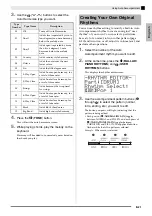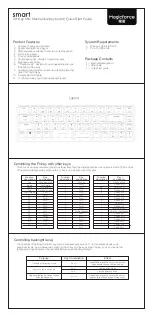
E-22
Using Auto Accompaniment
4.
Use the instrument part buttons (
through
) to select the part (drums, bass etc.) you
want to edit.
The name of the part you select will appear on the
display. Rhythm patterns are made up of the eight parts
shown below.
•
Button illumination does not change when you press
the instrument part buttons (
through
). Button
illumination indicates whether there is
accompaniment data corresponding to each part.
Example:
When bass is selected
5.
Edit the selected part as desired.
The table below describes the parameters you can edit.
•
Use the
(
u
) and
(
i
) buttons to select a
parameter, and the
(
w
,
q
) buttons to change its
setting. You also can use shortcut buttons (see table
below) to select parameters.
•
Pressing the
(
w
,
q
) buttons at the same time
will return the currently selected parameter to its
initial default setting.
•
Pressing the
(
START/STOP
) button during an
edit operation will sound the accompaniment pattern
with the edits you have made up to that point.
Pressing the
(
ACCOMP ON/OFF
) button will
sound only the instrument part you are editing.
Procedure continues on page E-23.
ck
cl
cm
cn
co
cp
cq
cr
Drums
Percus-
sion
Bass
Chord 1 Chord 2 Chord 3 Chord 4 Chord 5
Parts
Instrument part name
Parameter
Description
Setting
Shortcut
Button
Rhythm
Select:
Rhythm
Replaces the part
(drum, bass, etc.)
accompaniment
data with that of
the specified
rhythm number.
*
1
001 to 190:
Rhythm
number
*
2
*
3
Tone
Select:
Tone
Switches the part
tone (instrument)
to that of the
specified tone
number.
001 to 250: Tone
Numbers
*
2
*
4
Prt:
Part on/
off
Toggles each part
on or off.
OFF:
Mutes the part.
ON:
Sounds the
part.
Vol:
Volume
level
Controls the
volume level of
each part.
000 to 127
Pan:
Panning
(position)
Controls whether
the sound of the
part can be heard
from the left side or
right side.
–64 to 0 to 63
*
5
Reverb:
Reverb
Controls the level
of the reverb effect
(page E-13) applied
to the part notes.
000 to 127
Chorus:
Chorus
Controls the level
of the chorus effect
(page E-13) applied
to the part notes.
000 to 127
*1
Replacing part accompaniment data clears all edits to the
currently selected accompaniment data made up to that
point.
*2
Sequential numbers starting from 001, which is the first
rhythm of the first group (POPS/JAZZ). See the “Tone
List” (page A-1) and “Rhythm List” (page A-4) for
information on the numbering system.
*3
In the case of the intro and ending, specifying a rhythm
for one part (drum, bass, etc.) will cause the same rhythm
to be specified automatically for all of the other parts of
the pattern.
*4
Only drum set sounds (tone numbers 237 through 250)
can be selected for drum parts and percussion parts.
Drum set sounds cannot be selected for the bass and the
chord 1 through chord 5 parts.
*5
A smaller value shifts leftward, while a larger value shifts
rightward. A value of zero specifies center.















































